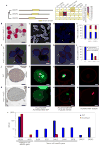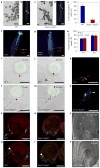Sperm cells are passive cargo of the pollen tube in plant fertilization
- PMID: 28585562
- PMCID: PMC5960590
- DOI: 10.1038/nplants.2017.79
Sperm cells are passive cargo of the pollen tube in plant fertilization
Abstract
Sperm cells of seed plants have lost their motility and are transported by the vegetative pollen tube cell for fertilization, but the extent to which they regulate their own transportation is a long-standing debate. Here we show that Arabidopsis lacking two bHLH transcription factors produces pollen without sperm cells. This abnormal pollen mostly behaves like the wild type and demonstrates that sperm cells are dispensable for normal pollen tube development.
Conflict of interest statement
The authors declare no competing financial interests.
Figures


References
MeSH terms
Substances
Grants and funding
LinkOut - more resources
Full Text Sources
Other Literature Sources
Molecular Biology Databases

